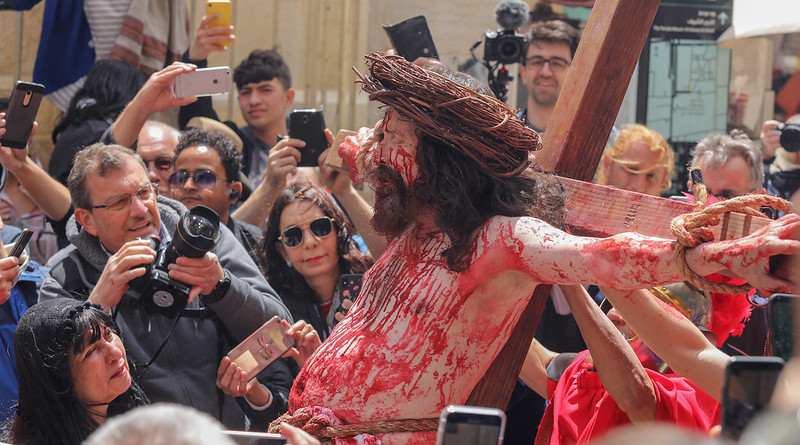Procession of the Holy Blood (Healig Bloedprocessie)
Faith, History, and Civic Pride Coloring the Streets of Bruges
2026/05/13
Every spring, the medieval city of Bruges in Belgium becomes the stage for one of Europe’s most solemn religious events: the Procession of the Holy Blood. The Heilig Bloedprocessie is a renowned religious festival in Belgium, where a relic said to be stained with the blood of Christ is carried through the streets of Bruges. Its origins date back to the late 12th and early 13th centuries. Held on Ascension Day, this traditional event attracts both locals and visitors from around the world, offering a grand parade woven from faith and history. Whether you are drawn by spirituality or fascinated by tradition and history, this is an unforgettable opportunity to experience the very soul of Bruges.
The sound of church bells, the shimmer of intricately embroidered robes, the scent of incense drifting over cobblestones, and the sweet aroma of spring flowers and pastries fill the air. The Procession of the Holy Blood is a living ritual that connects Bruges’ past and present, enveloping the city in color, music, and a powerful sense of community.
Main Attractions
The Grand Procession
The main highlight is the grand parade, where over 1,700 citizens dressed in biblical and medieval costumes march through the city. Scenes from the Old and New Testaments and key moments from Bruges’ history are vividly reenacted. The climax comes when the reliquary containing the “Holy Blood” is carried in a golden shrine through the streets, accompanied by solemn hymns and a hushed, awestruck crowd.
Costumes and Decorations
Participants wear hand-embroidered robes, Roman armor, biblical costumes, and medieval attire, each crafted with meticulous attention to detail. The city is adorned with banners, flowers, and religious symbols, transforming Bruges into a magnificent open-air stage. The feel of velvet and gold thread, the weight of the costumes, and the sight of thousands in costume create a truly breathtaking spectacle.
Traditional Food & Drink
Visitors can enjoy crispy Bruges fries, waffles dusted with powdered sugar, local beers, and pastries. The fragrance of spring flowers and incense, along with the smell of freshly baked pies, fills the cobbled streets and heightens the festival’s sense of excitement.
Cultural and Historical Background
The origins of the Procession of the Holy Blood (Heilig Bloedprocessie) date back to the late 12th and early 13th centuries. According to legend, Thierry d’Alsace, Count of Flanders, brought the relic—said to be stained with the blood of Christ—back from Jerusalem after the Second Crusade (1147–1149), and enshrined it in Bruges’ Basilica of the Holy Blood in 1150.
At first, the relic was displayed only during Holy Week (Easter) and other important religious occasions, in solemn ceremonies inside the basilica. But from the late 13th century, the relic began to be paraded through the city, evolving into a large-scale procession in which believers and citizens could participate. As Bruges grew into a major commercial center in medieval Europe, the procession became a symbol of both faith and urban prosperity.
Despite the challenges of the Reformation, the French Revolution, and two World Wars, the Procession of the Holy Blood has been preserved by the citizens of Bruges. The costumes and performances have been refined over time, and today more than 1,700 people participate, with over 30,000 spectators. In 2009, it was inscribed on the UNESCO Intangible Cultural Heritage list, and continues to be a “living history” that symbolizes the pride, faith, and intergenerational bonds of Bruges’ people.
Participant Voices
When the relic passed before me, the entire city fell silent. It felt as if time had stopped. The costumes, music, and solemn atmosphere were overwhelming. After the parade, I learned that almost every family in Bruges is involved in some way, and I was deeply moved by the community’s pride and faith.
Fun Facts
- The relic is enshrined in the Basilica of the Holy Blood on Burg Square in Bruges.
- The procession has continued almost uninterrupted for over 750 years, even through wars and political upheaval.
Festival Dates
The Procession of the Holy Blood is held every May on Ascension Day in Bruges. For details, check the official tourism website or the Basilica of the Holy Blood’s event page.
The event schedule is subject to change. Please check the official website for the most up-to-date information.
Information
| Name | Procession of the Holy Blood (Healig Bloedprocessie) |
| Country | Belgium |
| Area | Bruges |
| Date | 2026/05/13 |
| Link |
Upcoming Festivals
Dia de la Virgen de Guadalupe Mexico
A Festival Weaving Faith, Fervor, and Mexican Identity
2025/12/11L'Escalade Switzerland
Geneva’s Grand Winter Festival of Courage, Chocolate, and Community
2025/12/12Umkhosi Wokweshwama South Africa
The Zulu First Fruits Festival—A Sacred Celebration of Land, Ancestors, and Renewal
2025/12/12Lucia Festival (St. Lucia's Day) Sweden
A Festival of Light Illuminating the Nordic Darkness
2025/12/15Las Posadas Mexico
The Luminous Quest for Sacred Shelter
2025/12/22Noche de Rabanos (Night of the Radishes) Mexico
A celebration blending art, farming heritage, and cultural traditions
2025/12/23Chant of the Sybil on Majorca Spain
A Medieval Prophecy Echoes Through Majorcan Christmas
2025/12/23‘Hatajo de Negritos’ and the ‘Hatajo de Pallitas’ Peru
A Christmas Festival of Rhythm, Faith, and Afro-Andean Heritage in Peru’s Ica Region
2025/12/24Harbin International Ice and Snow Sculpture Festival China
A Frozen Wonderland Where Art and Adventure Merge
2025/12/24Takanakuy Peru
The Andean Festival of Reconciliation by Fist—How Confrontation Creates Year-End Peace and Bonds


